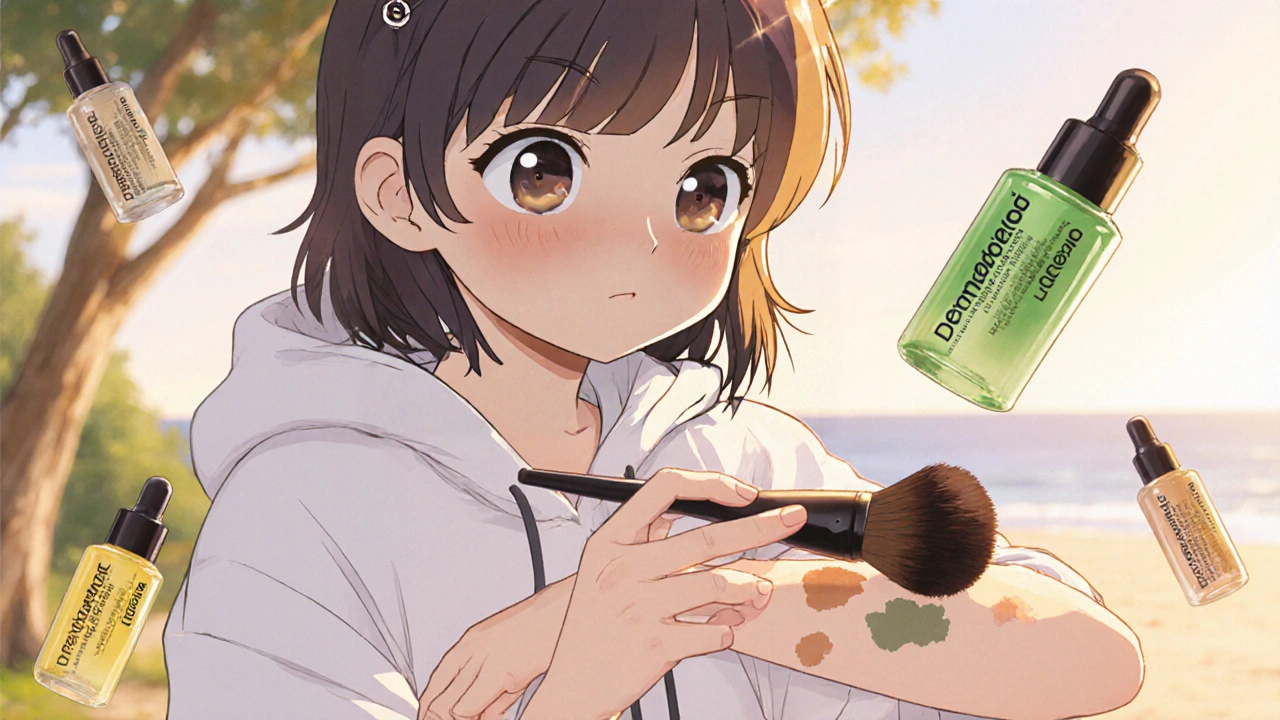Vitiligo Camouflage: Best Cosmetic Options and Techniques for Daily Coverage
16 Nov, 2025What Is Vitiligo Camouflage?
Camouflage for vitiligo isn’t just makeup. It’s a targeted, medical-grade approach to covering white patches on the skin caused by the loss of pigment-producing cells. Unlike regular foundation, these products are designed with higher pigment concentration-up to 25% more than standard cosmetics-to match skin tones accurately, even on stubborn, light patches. The goal isn’t to hide your skin, but to restore a sense of normalcy. Many people with vitiligo say the emotional relief is just as important as the visual change.
According to dermatologists like Dr. Davin Lim in Brisbane, camouflage works best when used alongside medical treatments like phototherapy or topical creams. It doesn’t cure vitiligo, but it gives people control over how they look while waiting for those treatments to take effect. A 2022 study in the Indian Journal of Dermatology found that nearly 8 out of 10 people with vitiligo actively look for camouflage options. That’s not just about vanity-it’s about confidence in social settings, at work, or even just walking down the street.
Temporary vs. Permanent Camouflage: What’s the Difference?
There are two main paths: temporary and permanent. Temporary camouflage means applying products every day. Permanent camouflage, also called micropigmentation, is a form of tattooing that implants pigment into the skin to last months or years.
Temporary options include liquid dyes, self-tanners, and specially formulated foundations. These are easy to start with, affordable, and reversible. But they require daily effort-sometimes 12 to 15 minutes each morning. Permanent camouflage, on the other hand, removes the daily routine. But it’s not simple. It requires a stable condition: your vitiligo must not be spreading for at least 12 months. If it’s still active, the pigment can fade unevenly or create a halo effect around the treated area.
Permanent camouflage works best on the lips, wrists, elbows, knuckles, and underarms-areas where makeup tends to rub off quickly. But it’s less reliable on hands and feet, where friction and movement cause pigment to fade up to 40% faster. One patient in Brisbane reported that after two micropigmentation sessions on her knuckles, the color faded noticeably within eight months. She now uses a combination: permanent on her lips, temporary on her hands.
How Temporary Camouflage Products Work
Not all makeup is created equal for vitiligo. Regular foundations won’t cut it. You need products made specifically for pigment loss. Brands like Dermablend and Dermacolour are the gold standard. They’re tested on real vitiligo skin and contain more pigment, better color stability, and often include light SPF protection.
There are three types of formulas:
- Water-based: Best for normal or dry skin. Feels lightweight, sets in about 90 seconds.
- Oil-free: Contains silicone-based ingredients like dimethicone. Ideal for oily skin or hot climates like Brisbane’s summers.
- Water-free (anhydrous): Waterproof, long-lasting. Made with waxes and oils. Takes 3-5 minutes to set, but lasts up to 14 hours-even through sweat and light rain.
Self-tanners are another option. They give you a sun-kissed look that lasts 4-7 days. But they’re tricky. If applied unevenly, they can make patches look patchier. Experts recommend using a small brush and blending outward from the edge of the white area.
Don’t try home remedies like henna, iron filings, or indigo carmine. A 2022 survey from the Vitiligo Society showed only 32% of users were happy with these. The colors don’t match well, and some can irritate sensitive skin.
Color Matching: The Most Important Step
Getting the right shade is half the battle. Many people give up after their first try because the product looks ashy, gray, or too orange. That’s usually because they matched under artificial light or didn’t test enough shades.
The key? Natural daylight. Go outside, hold the product up to your skin, and look at it from a few feet away. If it blends, it works. If it stands out, keep looking.
Professional color matching can make a huge difference. Certified camouflage consultants use color theory to neutralize undertones. For example, if your vitiligo patch has a pinkish cast, a green-based corrector underneath can cancel it out before applying the main color. This technique, called color correction, is taught in training programs by Dermablend and the Vitiligo Society.
Most people need 3-5 tries to get it right. One Reddit user, u/VitiligoWarrior, said it took him six months of trial and error before he found his perfect match. Then he booked a session with a certified specialist-and it changed everything.
How to Apply Camouflage Like a Pro
Application matters as much as the product. Here’s the step-by-step most dermatologists recommend:
- Cleanse: Use a gentle, pH-balanced cleanser. Avoid oil-based cleansers-they can break down the camouflage.
- Moisturize: Wait 10 minutes after moisturizing. Too much product underneath can cause streaking.
- Color correct (if needed): Use a green or yellow corrector for pink or gray patches. Blend well.
- Apply foundation: Use a dense brush or sponge. Pat, don’t rub. Build in thin layers.
- Set: For water-based formulas, wait 90 seconds. For anhydrous, wait 3-5 minutes before touching or applying more layers.
- Finish: Dust lightly with translucent powder if needed. Avoid heavy sprays-they can lift the product.
Removing camouflage can be just as tricky. Waterproof formulas require oil-based removers. Don’t scrub. Use a cotton pad soaked in micellar water or baby oil, and let it sit for 30 seconds before gently wiping. Many users report irritation from harsh removal-so choose your remover wisely.
Micropigmentation: What to Expect
Micropigmentation is a medical procedure, not a salon tattoo. It’s done by trained dermatologists or certified pigment specialists using sterile needles and inert iron oxides-pigments approved for long-term skin use. The pigment is implanted 6 microns in size, deep enough to last, but shallow enough to avoid toxicity.
Each session lasts 45-90 minutes, depending on the size of the area. You’ll need 2-3 sessions, spaced 6-8 weeks apart. The first session builds the base color. The second refines it. The third adds depth and blends edges.
Costs range from $300 to $800 per session, depending on location and area treated. Facial treatments have a 74% satisfaction rate. Hands and feet? Only 48%. That’s because skin there moves more, sheds faster, and absorbs pigment unevenly.
Before you commit: make sure your vitiligo has been stable for at least a year. If it’s still spreading, you risk uneven results. A 2022 case series showed 18% of patients with active vitiligo developed halos around their tattooed areas-making the condition look worse.

Real Results: What People Say
Surveys from the Vitiligo Society show 82% satisfaction with foundation-based camouflage. Dermablend scores 4.6 out of 5 for color accuracy. But cost is a barrier. A single product can run $25-$45. For some, that’s too much to spend monthly.
One woman from Queensland told her dermatologist: “I stopped wearing tank tops for 12 years. After three weeks of using Dermablend, I wore one to the beach. I cried. Not because of the patches-but because I finally felt like I could be seen.”
Permanent camouflage stories are more polarized. One man in Melbourne said lip micropigmentation gave him back his confidence after 15 years. Another woman in Sydney had her hands done and needed three touch-ups in a year. She now uses temporary makeup on her hands and keeps the lip work.
What’s New in Vitiligo Camouflage
The field is evolving fast. In 2023, NUE Conceal launched a new pigment set with 28 shades designed for deeper skin tones-something many brands ignored before. L’Oréal’s ModiFace AI tool is in beta testing and will soon let users upload a photo to find their perfect match virtually. That could cut down weeks of trial and error.
Teledermatology is also growing. Now, 65% of major camouflage brands offer virtual color matching. You can send a photo, get a personalized recommendation, and order online-all without leaving your home.
Experts agree: camouflage isn’t a replacement for medical treatment. It’s a companion. As Dr. Nithya Krishnaswamy puts it, “It helps patients feel like themselves while waiting for the science to catch up.”
Where to Start
If you’re new to camouflage:
- Start with a temporary product like Dermablend or Dermacolour.
- Buy a small sample size first-don’t commit to full price until you’re sure.
- Apply in natural light. Match at the edge of the patch, not the center.
- Watch YouTube tutorials from certified specialists, not beauty influencers.
- Book a consultation with a dermatologist who specializes in pigment disorders.
If you’re considering micropigmentation:
- Confirm your vitiligo has been stable for 12+ months.
- Ask for before-and-after photos of patients with similar skin tone and patch location.
- Check if the practitioner is certified by the Dermopigmentation Center or equivalent.
- Start small-lips or wrists-before tackling larger areas.
There’s no one-size-fits-all solution. But there is a way that works for you. It might take time, trial, and patience-but the goal is simple: to help you feel like yourself again.
Can I use regular foundation to cover vitiligo?
Regular foundation doesn’t have enough pigment to cover vitiligo patches effectively. It often looks patchy, gray, or ashy. Products made specifically for vitiligo, like Dermablend or Dermacolour, contain up to 25% more pigment and are designed to blend with depigmented skin. They’re the only options proven to give natural-looking, long-lasting coverage.
How long does vitiligo camouflage last?
Temporary camouflage lasts 6-14 hours, depending on the product and skin type. Water-based formulas wear off faster with sweat or water contact. Anhydrous (waterproof) formulas last longer, even through light rain. Self-tanners last 4-7 days but can fade unevenly. Permanent micropigmentation lasts 1-3 years, but may need touch-ups every 12-18 months, especially on hands and feet.
Is micropigmentation safe for vitiligo?
Yes, but only if your vitiligo has been stable for at least 12 months. If the condition is still active, pigment can fade unevenly or create a halo effect around the treated area. Always choose a practitioner trained in vitiligo-specific micropigmentation. They use sterile, medical-grade iron oxides and know how to avoid areas where skin is prone to friction or movement.
Can camouflage make vitiligo worse?
No, camouflage products don’t cause vitiligo to spread. However, poor application or harsh removal methods can irritate the skin, which might trigger a reaction in sensitive individuals. Always use gentle cleansers and avoid scrubbing. Also, micropigmentation on active vitiligo can lead to uneven results, but that’s due to the condition, not the procedure itself.
How much does vitiligo camouflage cost?
Temporary products cost $25-$45 per item and last 2-4 months with daily use. Micropigmentation costs $300-$800 per session, and most people need 2-3 sessions. Some clinics offer payment plans. Insurance rarely covers cosmetic camouflage, but some patients use health savings accounts (HSAs) if prescribed by a dermatologist.
Do I need to see a specialist to use camouflage?
You don’t have to, but it helps. Many people struggle with color matching and application at first. Certified camouflage consultants-often dermatology nurses or trained aestheticians-offer personalized training. They teach you how to use color theory, choose the right product, and apply it correctly. The Vitiligo Society reports that 89% of patients achieve better results after one training session.

satya pradeep
November 18, 2025 AT 01:10Kathryn Ware
November 19, 2025 AT 16:54shubham seth
November 19, 2025 AT 19:56kora ortiz
November 21, 2025 AT 05:42Elia DOnald Maluleke
November 21, 2025 AT 06:15Jeremy Hernandez
November 22, 2025 AT 20:21Leslie Douglas-Churchwell
November 23, 2025 AT 20:24Tarryne Rolle
November 24, 2025 AT 04:11Kyle Swatt
November 24, 2025 AT 16:59Holli Yancey
November 24, 2025 AT 20:26Prem Hungry
November 24, 2025 AT 22:52